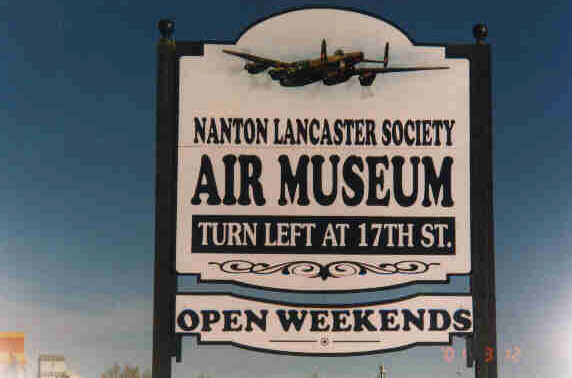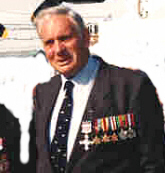 Museum
Museum  |
Bomber Command
|
Aircrew Chronicles
|
Aircrew Losses
|
Nose Art
|
BCATP
|
Lancaster
|
Media
|
Bomber Command
|
Aircrew Chronicles
|
Aircrew Losses
|
Nose Art
|
BCATP
|
Lancaster
|
Media
 Museum
Museum  |
Bomber Command
|
Aircrew Chronicles
|
Aircrew Losses
|
Nose Art
|
BCATP
|
Lancaster
|
Media
|
Bomber Command
|
Aircrew Chronicles
|
Aircrew Losses
|
Nose Art
|
BCATP
|
Lancaster
|
Media
Bomber Command Museum Archived Newsletters
This year marks the 60th anniversary of the first flight of the Lancaster. With this in mind the Society will "return to its roots" and focus on this very special aircraft at our annual summer event to be held August 18, 2001. The planning of special displays, presentations and guest speakers is currently under way as we focus on the Lancaster's design, construction, wartime operation, post-war history, and the restoration and preservation of this remarkable aircraft. Details of the dayÔs agenda and ticket costs for the informal dinner will be forwarded to all members in June. |
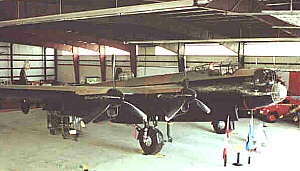 The Bazalgette Lancaster F2-T (FM-159) will be the central attraction August 18, 2001. The first Lanc flew 60 years ago. |
|
Progress is being made on the Anson Mk.II which has been on hold for some time. On Tuesday work nights, Harry Volk and John Green have teamed up to complete the three centre fuselage floors and gone on to cutting out the fuselage formers. Harry has been making templates for the formers from the drawings on hand. Project leader Rob Pedersen has now moved to Nanton from High River and when settled in will also be part of the crew on Tuesday work nights. Rob, his daughter Krista, friend Vicki, and Vicki's son and daughter, have been working intermittently on other days of the week. They have restored several smaller components of the Anson over the past few months. In the next few years we expect an Anson to arise from the multitude of components now being restored. |
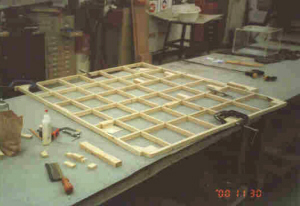 Anson floor frames under construction. |
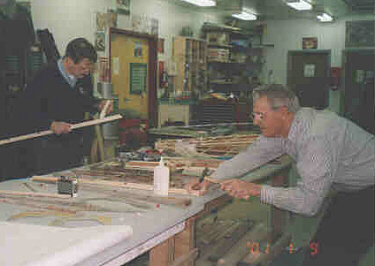
|
Harry Volk and John Green restoring the floors for the Anson Mk.II. Harry is a new resident of Nanton and has formerly volunteered at the Calgary Aero Space Museum and at the British Columbia Aviation Museum on Vancouver Island. |
|
The Cessna Crane is a military version of the Cessna T-50, designed as a five-seat, light transport commercial aircraft, first flown in 1939. the Crane began service as an advanced, twin-engined trainer with the Royal Canadian Air Force in 1941. This aircraft designated as AT-17 and UC-78 was also used by the United States Army Air Force. In the U.S.A. it acquired the nickname "Bamboo Bomber" because of the aircraft's largely wood construction. At the beginning of the second World War, the British-built Airspeed Oxford and Avro anson Mk.I were the only twin-engined trainers available for service with the British commonwealth Air Training Plan (BCATP) in Canada. Originally the American-built Cessna Crane was intended to serve only a mnor role (initially 180 were ordered in 1940) until the Canadian built Avro Anson Mk.IIs were available in greater numbers. However, by January of 1941, 644 Cranes had been taken on strength by the RCAF. A total of 820 Cranes saw service with the BCATP and the RCAF up until 1947. |
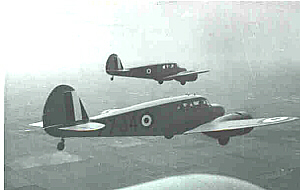 |
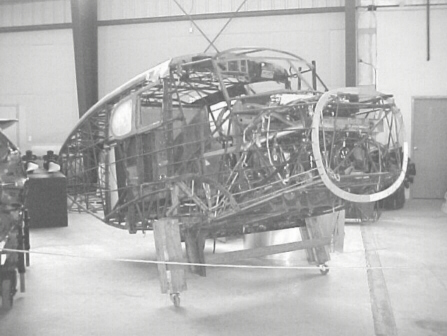
The "fly-past" at the Society's August 18, 2001, event, will see Gordon Jones flying his former BCATP, trainer, marking 60 years since his first flight in a Tiger Moth. This remarkable combination of man and machine have been part of many NLS fly-past's in recent years. Gordon and his wife Linora, whom he married in 1944, have five children. After retiring from many years of farming in the High River area they spent six years operating a charter flight service and flight training school at the High River airport. Gordon has played an active role in his community spending 15 years as a Foothills M.D. councilor and 33 years as a Rotarian. He is also a member of the International Flying FarmerÔs and a long time supporter of the Nanton Air Museum. |
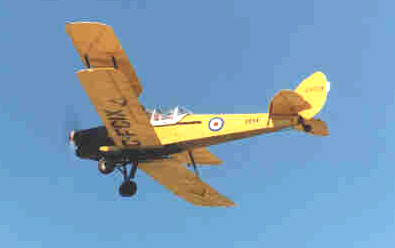 |
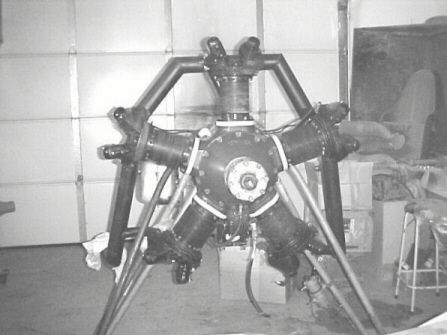
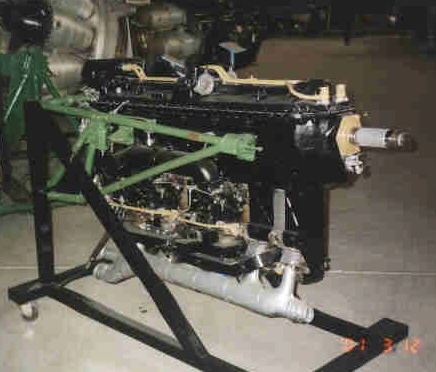 The above engine is a de Havilland Gipsy Queen. It was used on several aircraft including the D.H. Dragon Rapide, the D. H. Dove and others. It was originally labeled the Gipsy Six, but the RAF referred to it as the "Queen." This engine was made ready for display by volunteer Jack Craig. |
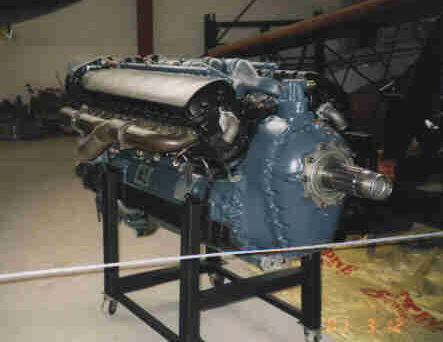 The 12 cylinder Allison V-1710 engine pictured here was donated by Milt and Bonnie Ulle, Foremost, AB. This engine type was used in several WWII aircraft. The display engine is the port engine from a P-38. "Buck" Koral assisted by other volunteers worked on this display. |
When the museum's Blenheim was unveiled in August 2000, some components were still missing. The upper cowlings were not in place nor were the ailerons and starboard elevator. Some of the Plexiglas was yet to be installed. Over winter the elevator was restored and covered with fabric. The ailerons are presently under restoration. To date we are still searching for original upper cowling sections and engine nacelles components (in any condition). Acquiring such would certainly speed up the process of getting the engines totally enclosed. If these items are not found in the near future, work will go ahead on making them from scratch. Once all the above items are restored and/or made, they will be painted and installed. The remaining Plexiglas to complete the cockpit canopy will be formed shortly. Charley Cobb, one of our Calgary volunteers, has restored and installed odds and ends like the pitot head and the antenna mast. This summer should see the missing parts of the Blenheim in place and this project entirely completed as a static display. |
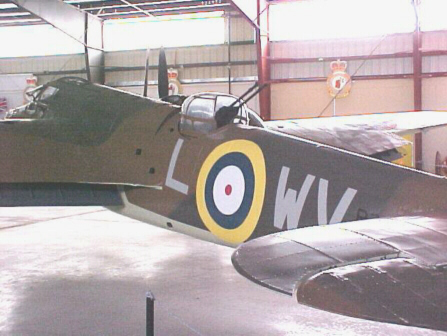 The Barry Davidson Memorial Blenheim. |
On September 1, 2000, I was employed as "half-time" Museum Manager. Previous to that I had worked at the museum part-time doing administrative work, attending monthly meetings, etc., since November 1997. Becoming "Museum Manager" was, from my point of view, my "dream" job! With several of my family members having served in the Canadian Military during and after the war and having also worked for the military in Edmonton, my interest in the museum and its focus on WWII history was a "built-in." During the past three years my interest in everything about the museum has grown and because of this, the half-time paid position has become "full-time" with my additional volunteer hours. I am eternally grateful to the Society for the opportunity and privilege of being part of this great effort. |
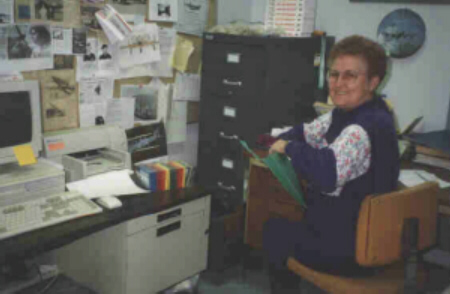 - she is the Society's first "full time - part time" employee |
Pictured is a Halifax bomb bay door that was given to NLS by "57 Rescue," a Scottish , aircraft recovery group that investigates WWII crash sites. Transportation from Scotland was courtesy of No. 415 Squadron Greenwood, N.S. NLS extends a grateful THANKS to 57 RESCUE and 415 Sqdrn. for the Halifax bomb bay door. |
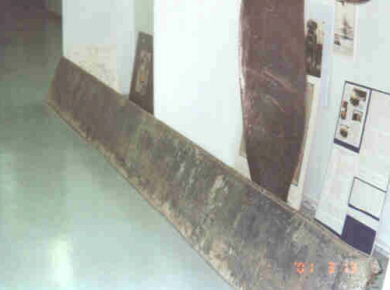
|
Yale # 3404 will be the summer project for the NLS shop if, as in the past, NLS obtains a student employment grant for hiring first year AME students from the two-year AME program at Southern Alberta Institute of Technology. The Yale project was placed on a "back burner" over the last two years, while efforts were concentrated on the restoration of the Blenheim bomber. With the Blenheim now in the final stages of restoration, the Yale will become this summerÔs project for the AME students. As first year AME students are fresh from their sheet metal instruction, the wing restoration will be concentrated on first. Marcus Stephenson, Calgary, a good friend of the Society has in the last two years restored the Yale's engine mount and fuselage forward tubing section. The fuselage can now be assembled on its undercarriage, while awaiting restoration of the wings. |
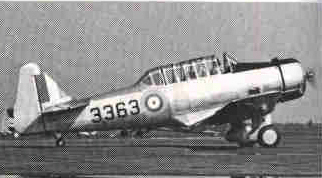 Restoration of N. A. Yale #3404 will commence this summer. When completed it will look like the one pictured above. |
|
The ongoing restoration of the Lancaster continues. Over the winter Don Ellis, a new member/volunteer, restored the flight engineer's seat and is in the process of installing the proper Plexiglas nose "bubble." The bubble that was previously on the aircraft was an extra one made for the museum's Lancaster cabin section mockup (from the movie, Map of the Human Heart). This bubble was not molded for proper mounting on the "real" Lancaster. The proper nose bubble was made for NLS in a joint effort with the Calgary Aero Space Museum (CASM) a few years ago. Volunteer John Phillips, from High River, AB, has taken on the job of coordinating the restoration of the Lancaster to a state where the engines are runnable and the aircraft is taxiable. John, is a retired AME. He also has pilot licenses for both helicopter and fixed wing aircraft. Under his direction, a group of our volunteers will commence installing new wiring in the cockpit and engine locations on the "old bird" this summer. Installation of the restored navigator's table in the cockpit is planned as well. Several more upgrades of the Lanc will happen in the next few months. The Whitfield family from Sarnia, Ontario, are expected to spend two weeks in June working on FM-159. This will be the eighth year that the Whitfields, Paul, Louise and son Peter have worked at restoring the Lanc! They plan to install the Plexiglas in the front gun turret and continue working toward getting the engines "runnable." |
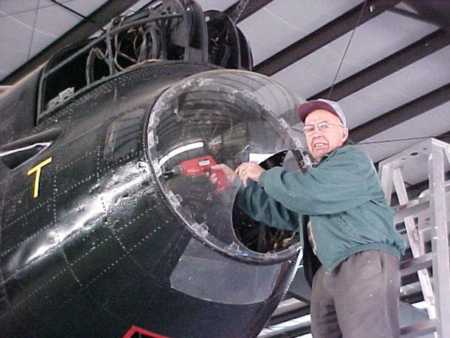 of having a new nose bubble installed. The photo shows volunteer Don Ellis in the process of fitting and installing the specially-made bubble. |
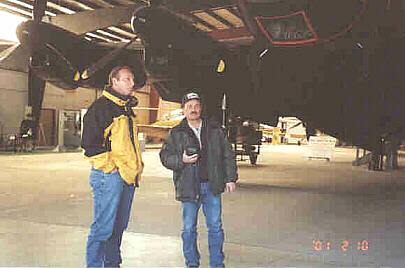 Glen White from Perth, Australia, stands with NLS President Dan Fox under the nose of Lancaster F2-T. Glen volunteers with the Air Force Assoc. Museum in Perth and works on their Lancaster. He visited the NLS museum in February. |
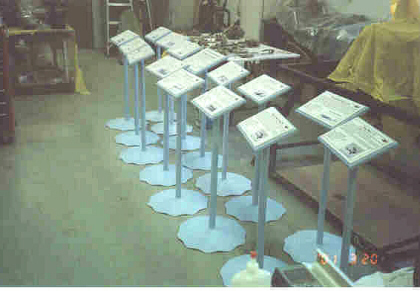 John Green built the 14 sign stands shown above standing in the museum shop. Dave Birrell made up the new display signage for them. Material cost was very minimal as John made use of worn disks from a farm implement and scrap pipe. More improvements to our signage is planned. This is just one example of recent upgrading of displays in the museum. |
